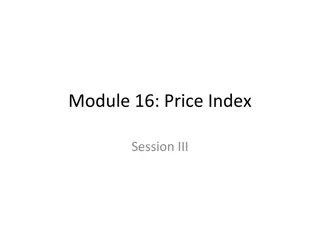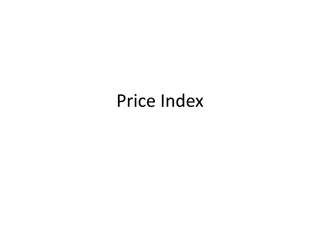Overview of Proposed Changes in Producer Price Index Formulas
The U.S. Bureau of Labor Statistics is considering transitioning from a modified Laspeyres formula to a geometric Young formula for elementary indexes in the Producer Price Index (PPI). This proposed change aims to enhance the accuracy and economic relevance of price measurements by utilizing a geometric mean index. The decision is influenced by axiomatic arguments that favor the geometric Young index due to its better properties from an economic perspective. The geometric Young index is believed to be closer to a feasible economic target, providing more reliable results. Axiomatic tests such as the time-reversal and transitivity tests are employed to assess the performance and biases of different index formulas.
Download Presentation

Please find below an Image/Link to download the presentation.
The content on the website is provided AS IS for your information and personal use only. It may not be sold, licensed, or shared on other websites without obtaining consent from the author. Download presentation by click this link. If you encounter any issues during the download, it is possible that the publisher has removed the file from their server.
E N D
Presentation Transcript
What is the Appropriate Index Formula to Estimate Producer Price Change? December 11, 2020 Robert Martin Jonathan Weinhagen 1 U.S. BUREAU OF LABOR STATISTICS bls.gov
Summary PPI currently uses a modified Laspeyres formula for all indexes Industry Commodity Final Demand - Intermediate Demand (FD-ID) Net inputs to industry Specifically, the Young formula is used at the elementary level We are proposing using the geometric Young for elementary indexes 2 U.S. BUREAUOF LABOR STATISTICS bls.gov 2 U.S. BUREAUOF LABOR STATISTICS bls.gov
Background In the 1990s, the Consumer Price index switched from a modified Laspeyres to a weighted geometric mean for most elementary-level price indexes PPI chose not to make this change because the Laspeyres index is a lower bound for a certain theoretical output price index Mathematically, a geometric mean index will be less than or equal to a Laspeyres index However, other axiomatic and economic arguments are more favorable to the geometric mean 3 U.S. BUREAUOF LABOR STATISTICS bls.gov 3 U.S. BUREAUOF LABOR STATISTICS bls.gov
Elementary index formulas Current Proposed ? ? ? ?? ? ? ??? ?? ?? ?? ??????= ?? ?????????= 0 0 ?=1 ?=1 ? ?= ??? ? ??? ? ?? ?? ?? ?=1 Numerically, ????????? ?????? Reasons to prefer the geometric Young index: Better properties from an axiomatic perspective It is likely closer to a feasible economic target 4 U.S. BUREAUOF LABOR STATISTICS bls.gov 4 U.S. BUREAUOF LABOR STATISTICS bls.gov
Axiomatic factors Time-reversal test the same result should be obtained whether the change is measured forward in time, from 0 to t, or backward in time, from t to 0. IMF, 2004 Young Geometric Young The Young index s failure is interpreted as an upward bias 5 U.S. BUREAUOF LABOR STATISTICS bls.gov 5 U.S. BUREAUOF LABOR STATISTICS bls.gov
Axiomatic factors (continued) Transitivity (or circularity) test: The chained index between two periods should equal the direct index between the same two periods. IMF, 2004 Young Geometric Young Does not necessarily imply direction of bias The axiomatic approach favors the geometric Young Young index also has upward formula bias when prices bounce (Reinsdorf, 1998) 6 U.S. BUREAUOF LABOR STATISTICS bls.gov 6 U.S. BUREAUOF LABOR STATISTICS bls.gov
Economic approach to output price indexes The Laspeyres index is a lower bound to the theoretical Fixed- Input Output Price Index (FIOPI) based on reference period technology and inputs FIOPI: Measures the revenue change if inputs and technology were fixed between periods (i.e., if firms could only adjust their mix of outputs in response to relative price changes) Different theoretical FIOPI exist for different productive capacities (levels of inputs and technology) In general, they are impractical to estimate 7 U.S. BUREAUOF LABOR STATISTICS bls.gov 7 U.S. BUREAUOF LABOR STATISTICS bls.gov
Economic approach (continued) Exception: the Fisher index approximates a FIOPI based on an intermediate (between the reference and current period) level of productive capacity (Diewert, 1983) The Fisher index is infeasible for PPI, but for PPI data, it is likely that: ??????> ??????????> ???? ??, and ??????> ????????? Switching to the geometric Young moves in the direction of this intermediate FIOPI 8 U.S. BUREAUOF LABOR STATISTICS bls.gov 8 U.S. BUREAUOF LABOR STATISTICS bls.gov
Simulations with PPI microdata We calculate monthly elementary-level indexes using: Current formula (Young) Proposed formula (Geometric Young) These are aggregated to create higher-level indexes (6-digit commodity, 6-digit industry, and FD-ID indexes) Upper level aggregation uses current modified Laspeyres (Lowe) methodology This presentation focuses on 6-digit commodity and FD indexes 9 U.S. BUREAUOF LABOR STATISTICS bls.gov 9 U.S. BUREAUOF LABOR STATISTICS bls.gov
Average annual percent change by commodity, 2008-17 Young (current methodology) Geometric Young Difference Category All Categories 1.520 1.250 0.270 Food 1.660 1.452 0.209 Energy -0.024 -0.404 0.380 Goods less food & energy 1.684 1.500 0.185 Wholesale and Retail Trade 1.087 -0.263 1.350 Transportation 2.037 1.638 0.398 Services less trade & transportation 1.078 0.640 0.438 Construction *Averages are non-weighted averages of changes in all relevant 6-digit commodity indexes. 1.603 1.554 0.049 10 U.S. BUREAUOF LABOR STATISTICS bls.gov 10 U.S. BUREAUOF LABOR STATISTICS bls.gov
Final Demand, 2010-2017 116 114 112 110 108 106 104 102 100 98 Young (current methodology) Geometric Young 11 U.S. BUREAUOF LABOR STATISTICS bls.gov 11 U.S. BUREAUOF LABOR STATISTICS bls.gov
PPI for Final Demand, 2010-2017 Total percent change Percent change per year Formula Young (current methodology) 13.07 1.56 Geometric Young 8.27 1.01 Difference 4.80 0.55 12 U.S. BUREAUOF LABOR STATISTICS bls.gov 12 U.S. BUREAUOF LABOR STATISTICS bls.gov
Final Demand less Trade and Finance, 2010-2017 116 114 112 110 108 106 104 102 100 98 Young (current methodology) Geometric Young 13 U.S. BUREAUOF LABOR STATISTICS bls.gov 13 U.S. BUREAUOF LABOR STATISTICS bls.gov
Final Demand less Trade and Finance, 2010-2017 Total percent change Percent change per year Formula Young (current methodology) 12.22 1.47 Geometric Young 10.16 1.23 Difference 2.06 0.24 14 U.S. BUREAUOF LABOR STATISTICS bls.gov 14 U.S. BUREAUOF LABOR STATISTICS bls.gov
A closer look at margin prices Ignoring Trade and Finance, formula differences line up with estimates for CPI data (e.g., Boskin 1996) Trade and Finance PPIs are based in part on gross margins Margin prices tend to exhibit Higher dispersion in general More extreme values Greater dispersion leads to greater formula differences 15 U.S. BUREAUOF LABOR STATISTICS bls.gov 15 U.S. BUREAUOF LABOR STATISTICS bls.gov
Coefficients of variation by industry Survivors Young Geo. Survivors LTR C.V. NAICS Description 11 21 22 23 31-33 42 44-45 48-49 51 52 53 Ag., Forestry, Fishing and Hunting Mining, Quarrying, and Oil and Gas Utilities Construction Manufacturing Wholesale Trade Retail Trade Transportation and Warehousing Information Finance and Insurance Real Estate and Rental and Leasing 0.48 0.42 0.84 0.23 0.3 1.41 1.68 0.35 0.4 1.26 0.33 0.17 0.18 0.28 0.11 0.13 0.47 0.35 0.16 0.16 0.33 0.16 54 Prof., Scientific, and Technical Services 0.13 0.1 56 61 62 71 72 Admin., Supp., Waste, & Rem. Services Educational Services Health Care and Social Assistance Arts, Entertainment, and Recreation Accommodation and Food Services 0.12 0.17 0.28 0.53 0.41 0.1 0.13 0.15 0.17 0.21 16 U.S. BUREAUOF LABOR STATISTICS bls.gov 16 U.S. BUREAUOF LABOR STATISTICS bls.gov
Extreme values and geometric means Dispersion is a concern if it is driven by extreme values Compared to an arithmetic mean, a geometric mean is: Less sensitive to large extreme values (price relatives) More sensitive to small (i.e., close to zero) extreme values Despite superior axiomatic and economic properties, the geometric Young may perform poorly when there are price relatives close to zero Meaning it may not reflect the central tendency of the elementary cell 17 U.S. BUREAUOF LABOR STATISTICS bls.gov 17 U.S. BUREAUOF LABOR STATISTICS bls.gov
Industry A (NAICS 44XXXX) 50 45 40 35 30 Frequency 25 20 15 10 5 0 0.2 0.4 0.6 0.8 1 1.2 1.4 1.6 Bin 1.8 2 2.2 2.4 2.6 5 More 18 U.S. BUREAUOF LABOR STATISTICS bls.gov 18 U.S. BUREAUOF LABOR STATISTICS bls.gov
Industry A (NAICS 44XXXX) From December 2007 to December 2008 Young index increased 52.3 percent Geometric Young index increased 25.3 percent Difference of 26.9 percentage points Excluding the lowest and highest relatives: Young index increased 61.4 percent Geometric Young index increased 57.7% Difference is only 3.7 percentage points 19 U.S. BUREAUOF LABOR STATISTICS bls.gov 19 U.S. BUREAUOF LABOR STATISTICS bls.gov
Industry B (NAICS 44YYYY) 18 16 14 12 Frequency 10 8 6 4 2 0 0.2 0.4 0.6 0.8 1 1.2 1.4 1.6 Bin 1.8 2 2.2 2.4 2.6 5 More 20 U.S. BUREAUOF LABOR STATISTICS bls.gov 20 U.S. BUREAUOF LABOR STATISTICS bls.gov
Industry B (NAICS 44YYYY) From December 2007 to June 2014 Young index increased 14.1 percent Geometric Young index fell 9.1 percent Difference of 23.2 percentage points Excluding the lowest and highest relatives, the difference is still 19.4 percentage points (+11.2% versus -8.1%) Excluding the top five highest and lowest relatives, the difference is 14.6 percentage points (+16% vs. +1.4%) 21 U.S. BUREAUOF LABOR STATISTICS bls.gov 21 U.S. BUREAUOF LABOR STATISTICS bls.gov
Implications for formula choice We examined the 20 industry/cycles with the largest formula differences. For about 75 percent, general dispersion seems to drive the differences rather than extreme values We then repeated the full index simulations with bounds of 0.05 and 20 on the monthly relatives Average Trade index gaps decrease by only 0.015 percentage points per year. Bounds of 0.25 and 4 decrease average gap by add l 0.026 Extreme values do not appear to explain much of the formula differences 22 U.S. BUREAUOF LABOR STATISTICS bls.gov 22 U.S. BUREAUOF LABOR STATISTICS bls.gov
Summary and recommendations We propose adopting a geometric Young formula for all elementary PPI This would resolve axiomatic and numerical issues with the current Young formula The geometric Young index may be closer to a feasible economic target (the FIOPI based on intermediate inputs and technology) Extreme margin changes do not appear to be driving results 23 U.S. BUREAUOF LABOR STATISTICS bls.gov 23 U.S. BUREAUOF LABOR STATISTICS bls.gov
Contact Information Jonathan Weinhagen Senior Economist Producer Price Index Program www.bls.gov/ppi 202-691-7709 weinhagen.jonathan@bls.gov 24 U.S. BUREAUOF LABOR STATISTICS bls.gov
References IMF/ILO/OECD/Eurostat/UNECE/World Bank. 2004. Producer Price Index Manual: Theory and Practice. Edited by P. Armknecht. Washington, DC: International Monetary Fund. https://www.imf.org/external/pubs/ft/ppi/2010/manual/ppi.pdf. Reinsdorf, Marshall B. 1998. "Formula Bias and Within-Stratum Substitution Bias in the U.S. CPI." The Review of Economics and Statistics (MIT Press) 80 (2): 175-187. doi:10.1162/003465398557375. Diewert, W. Erwin. 1983. "The Theory of the Output Price Index and the Measurement of Real Output Change." In Price Level Measurement, edited by W. Erwin and C. Montmarquette Diewert, 1049-1113. Ottawa: Statistics Canada. 25 U.S. BUREAUOF LABOR STATISTICS bls.gov 25 U.S. BUREAUOF LABOR STATISTICS bls.gov























